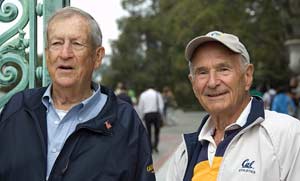 |
Sather Gate was once the literal gateway to the campus, back when Telegraph Avenue extended north to it (far left). Today it’s a campus landmark whose structural woes are being addressed before they worsen; the gate’s steel framework is corroding and expanding (left), affecting the integrity of the ornamental bronzework attached to it. (Courtesy of Sarah Wikander) |
Repairs to Sather Gate, a true campus icon, to start this week
Campus’s south portal is showing its age. But by next spring it will be ‘ready to weather another 100 years’
| 09 October 2008
BERKELEY — Starting this week, Sather Gate, the campus’s famous Beaux Arts south portal, will be gently dismantled, seismically fortified, and restored to its former majesty.
There are no plans to close down the nearly century-old gateway during the $1.5 million restoration project, and pedestrians and authorized vehicles will continue to pass through the area.
Originally the Telegraph Avenue entrance to the campus, Sather Gate has served as a hub for Cal spirit gatherings and political rallies through the Great Depression, World War II, the McCarthy era, and the Free Speech Movement. Over the decades, however, the gate’s steel core has corroded and expanded, warping its ornamental bronze cladding.
To begin the repair job, scaffolding will be erected at Sather Gate’s central archway this Friday, Oct. 10, as engineers and craftsmen prepare to remove the ornate brass-and-steel work. By Thanksgiving, only the gate’s four granite pillars, topped by glass orbs, will be standing. Campus officials in charge of the project expect to see the metal arch and portals returned to the columns next spring.
“The restored Sather Gate shouldn’t look much different than it does today, but it will be ready to weather at least another 100 years as the symbolic archway to learning and discovery,” says campus landscape architect Jim Horner.
Horner got word of the gate’s deterioration in 2007, when members of the UC Rally Committee, a student group that promotes Cal spirit, informed him that the gate had wobbled disturbingly when they were decorating it for a Homecoming-weekend event.
 Fundraising to help pay for the restoration is being undertaken by alumni from the Class of 1950, including Bud Murray and Don Reichert, who manned an information table at the gate last week. (Wendy Edelstein photo)
Fundraising to help pay for the restoration is being undertaken by alumni from the Class of 1950, including Bud Murray and Don Reichert, who manned an information table at the gate last week. (Wendy Edelstein photo)After an engineering study and consultation with metal workers, the campus authorized funds to launch the restoration. Meanwhile, the Class of 1950 decided to lead a “Save Sather Gate” fundraising campaign to pay for the restoration, which it hopes will be completed in time for its 60th reunion in 2010.
“We all agreed we wanted to support something that we could see and touch, something that would bring lasting memories,” says Bud Murray, president of the Class of 1950. “We’ve walked through that gate thousands of times. It’s seen flocks of demonstrations. It’s an icon.”
The gate was donated to UC Berkeley by Jane K. Sather in memory of her late husband, banker Peder Sather; construction was completed in 1910. Designed by John Galen Howard in French baroque style, it is topped by a star with the campus motto, Fiat Lux (“Let there be light”). Inlaid in the gate’s columns are eight marble bas-relief panels, sculpted by Bay Area artist Melvin Earl Cummings, that depict male and female nudes representing the eight fields of learning: letters, mining, medicine, law, electricity, agriculture, architecture, and art.
In 1910, however, the nudes embarrassed many students and offended Mrs. Sather, and the panels were promptly taken down. But in 1977 the panels were found — some under the bleachers at Edwards Stadium and others at the Amador Marble Company in Oakland — and re-attached to the granite columns.

